Analysis of Literary Texts | Assignment
VerifiedAdded on 2022/08/26
|8
|2240
|21
AI Summary
Contribute Materials
Your contribution can guide someone’s learning journey. Share your
documents today.
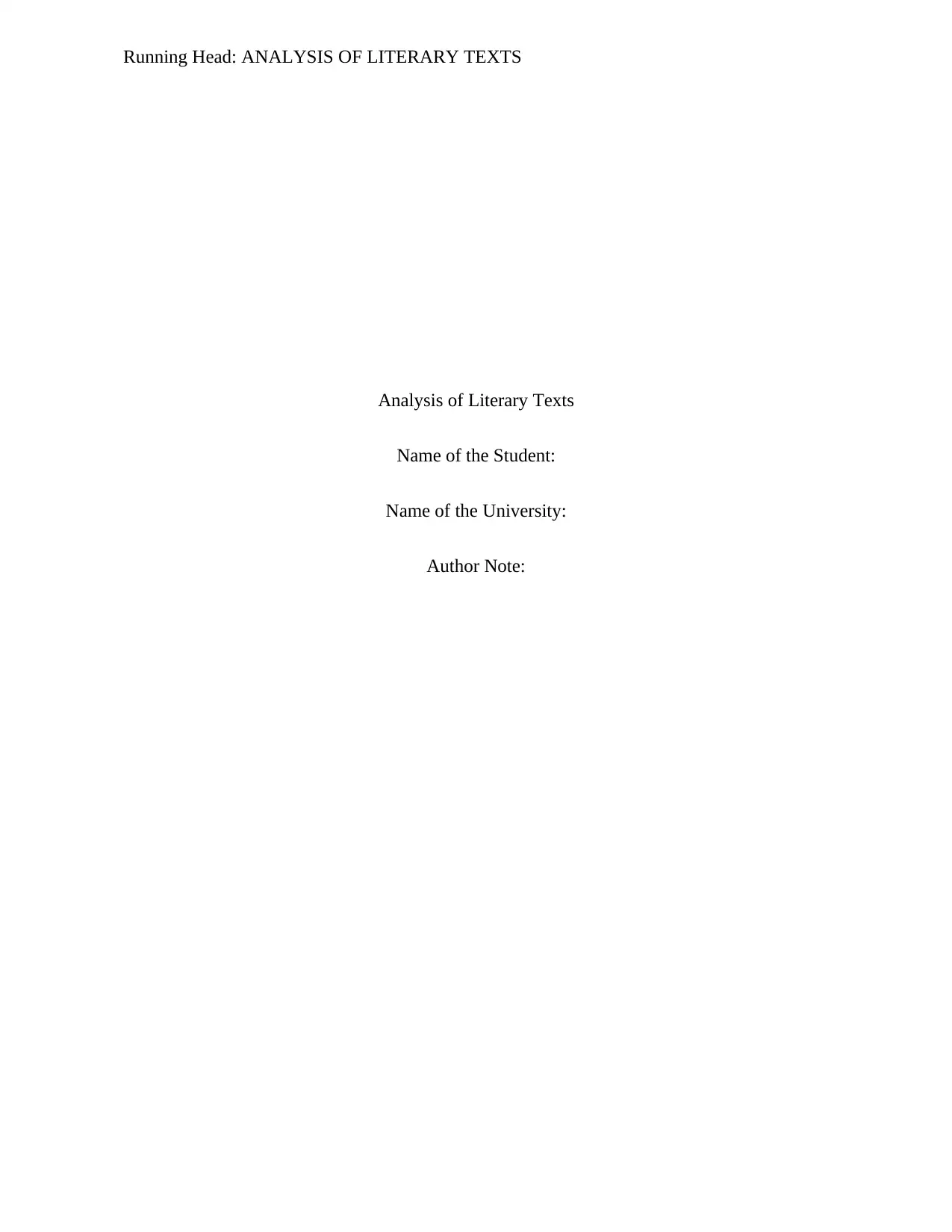
Running Head: ANALYSIS OF LITERARY TEXTS
Analysis of Literary Texts
Name of the Student:
Name of the University:
Author Note:
Analysis of Literary Texts
Name of the Student:
Name of the University:
Author Note:
Secure Best Marks with AI Grader
Need help grading? Try our AI Grader for instant feedback on your assignments.

1ANALYSIS OF LITERARY TETXTS
Part 2
Theme of “The Story of an Hour”
There are a few major themes in Kate Chopin’s “The Story of an Hour”. As the story
begins with the news of the death of Mr. Mallard, the themes of the story comes into a perfect fit
like that of a puzzle. Initially Mrs. Mallard experienced a certain amount of resistance in her
body and mind, as she made an attempt to deny the change that befell on her following the death
of her husband. As the initial shock and tears of the news passed away, she could knew that the
following years would belong to herself and no one else. This articulates the other theme of the
story, independence and liberty (de Deus Rocha, 2018). These two aspects were missing from
her life, as she never knew what it felt to be on her own free will. However, it is important to
keep in mind that she had been tied down by her marriage, her physical ailments, and even her
home from where she fails to depart throughout the entire short story. Death forms anther major
theme in “The Story of an Hour” as the characters are made to explore the possibility of the
various range of emotions that one might feel for the demise of their loved one. However, the
theme of death is portrayed in a very unusual light as the first news of death brought misery and
liberation with it. While the death of Mrs. Mallard at the end of the story was because of a heart
disease, that was caused due to extreme joy, this only the surface to the real cause beneath it.
To conclude, Chopin deliberately uses the words “joy that kills” in order to make her
readers understand that cause of Mrs. Mallards death was because of the moment when she knew
that the promise of a future of her own shall no longer exist as her husband is alive, and back
home- it kills her; literally and figuratively (KACHA, 2018).
Part 2
Theme of “The Story of an Hour”
There are a few major themes in Kate Chopin’s “The Story of an Hour”. As the story
begins with the news of the death of Mr. Mallard, the themes of the story comes into a perfect fit
like that of a puzzle. Initially Mrs. Mallard experienced a certain amount of resistance in her
body and mind, as she made an attempt to deny the change that befell on her following the death
of her husband. As the initial shock and tears of the news passed away, she could knew that the
following years would belong to herself and no one else. This articulates the other theme of the
story, independence and liberty (de Deus Rocha, 2018). These two aspects were missing from
her life, as she never knew what it felt to be on her own free will. However, it is important to
keep in mind that she had been tied down by her marriage, her physical ailments, and even her
home from where she fails to depart throughout the entire short story. Death forms anther major
theme in “The Story of an Hour” as the characters are made to explore the possibility of the
various range of emotions that one might feel for the demise of their loved one. However, the
theme of death is portrayed in a very unusual light as the first news of death brought misery and
liberation with it. While the death of Mrs. Mallard at the end of the story was because of a heart
disease, that was caused due to extreme joy, this only the surface to the real cause beneath it.
To conclude, Chopin deliberately uses the words “joy that kills” in order to make her
readers understand that cause of Mrs. Mallards death was because of the moment when she knew
that the promise of a future of her own shall no longer exist as her husband is alive, and back
home- it kills her; literally and figuratively (KACHA, 2018).

2ANALYSIS OF LITERARY TETXTS
Part 3
Cultural perspectives in “Everyday Use” by Alice Walker
African American writer, Alice Walker’s novels, and short stories are known for treating
the various insights in the black culture and its treatment of the black culture. The short story
“Everyday Use” portrays the cultural conflict that is present in the different sections of the
African American society. It is the story of struggles of survival in an environment that is hostile
(Elmore, 2019). The emerging consciousness poses a challenge in terms of bias of culture, along
with a fight against racism that leads to the creation of a different culture.
The opening lines give the readers an insight of how the mother and her second daughter
Maggie have prepared for the daughter who was sent away for studies, the comparatively fairer
skinned daughter, (Dee Webb, 2019). The demarcation between the two cultures, one being the
old and dominant African culture, Dee, has taken up a different name in order to resist the norms
that she refers to as repressive as she says- “She’s dead. I couldn’t bear it any longer being
named after the people who oppress me.” The other side of the line is the mother and her other
daughter, Maggie (Elmore, 2019). The mother is the guardian figure of the family, “a large, big-
boned woman with rough, man-working hands”. She has been a regular visitor of the church as
well as raised money for the education of her “fantasy” child, Dee. The white majority, which is
dominant, is although not directly portrayed within the narration of the story, but the presence of
the looming figure in the background is obvious. The number of changes that were taking place
in the characters over the very short period captured in the text is immense (ZHAO, 2017). Dee,
who initially regarded her own culture, as old and backdated, now understands that being black
Part 3
Cultural perspectives in “Everyday Use” by Alice Walker
African American writer, Alice Walker’s novels, and short stories are known for treating
the various insights in the black culture and its treatment of the black culture. The short story
“Everyday Use” portrays the cultural conflict that is present in the different sections of the
African American society. It is the story of struggles of survival in an environment that is hostile
(Elmore, 2019). The emerging consciousness poses a challenge in terms of bias of culture, along
with a fight against racism that leads to the creation of a different culture.
The opening lines give the readers an insight of how the mother and her second daughter
Maggie have prepared for the daughter who was sent away for studies, the comparatively fairer
skinned daughter, (Dee Webb, 2019). The demarcation between the two cultures, one being the
old and dominant African culture, Dee, has taken up a different name in order to resist the norms
that she refers to as repressive as she says- “She’s dead. I couldn’t bear it any longer being
named after the people who oppress me.” The other side of the line is the mother and her other
daughter, Maggie (Elmore, 2019). The mother is the guardian figure of the family, “a large, big-
boned woman with rough, man-working hands”. She has been a regular visitor of the church as
well as raised money for the education of her “fantasy” child, Dee. The white majority, which is
dominant, is although not directly portrayed within the narration of the story, but the presence of
the looming figure in the background is obvious. The number of changes that were taking place
in the characters over the very short period captured in the text is immense (ZHAO, 2017). Dee,
who initially regarded her own culture, as old and backdated, now understands that being black
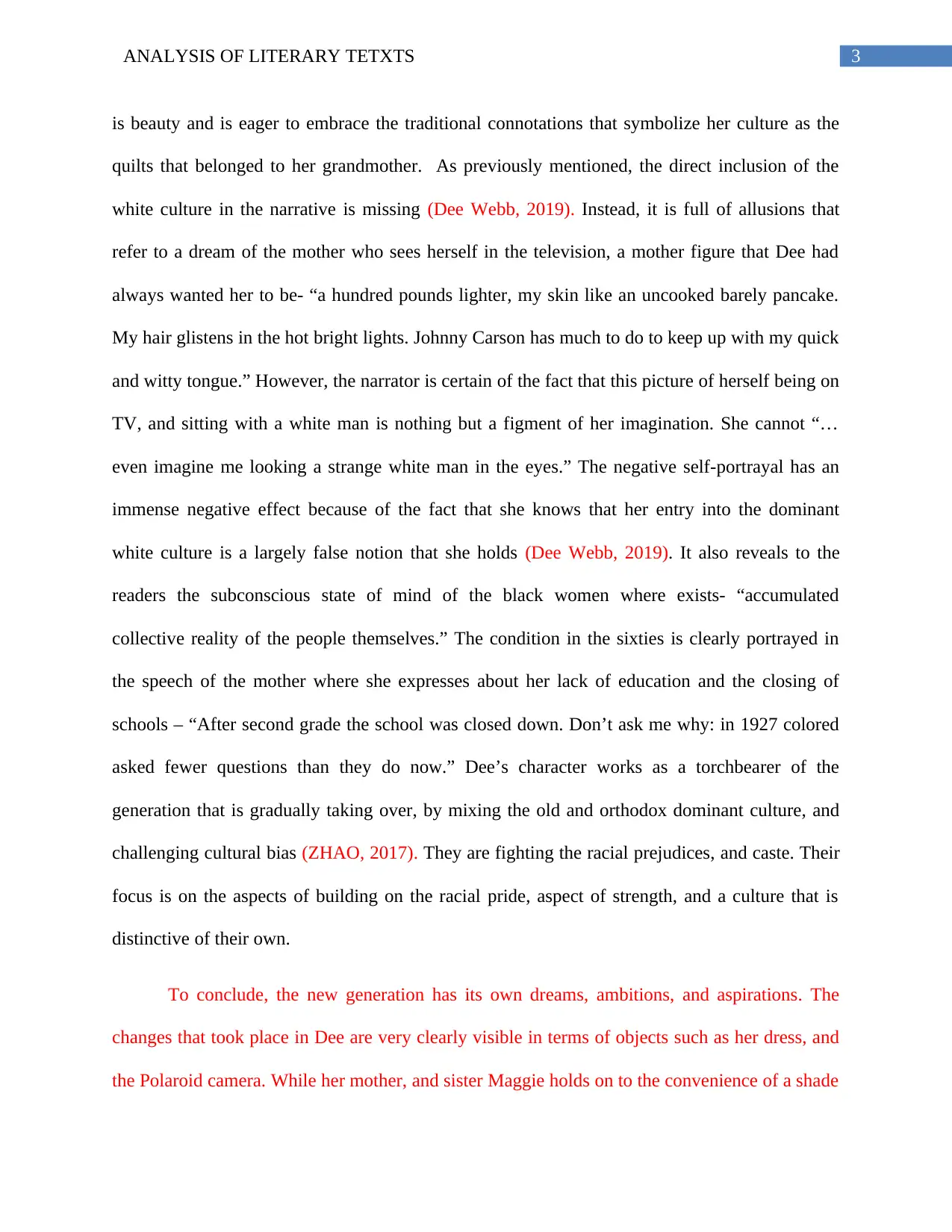
3ANALYSIS OF LITERARY TETXTS
is beauty and is eager to embrace the traditional connotations that symbolize her culture as the
quilts that belonged to her grandmother. As previously mentioned, the direct inclusion of the
white culture in the narrative is missing (Dee Webb, 2019). Instead, it is full of allusions that
refer to a dream of the mother who sees herself in the television, a mother figure that Dee had
always wanted her to be- “a hundred pounds lighter, my skin like an uncooked barely pancake.
My hair glistens in the hot bright lights. Johnny Carson has much to do to keep up with my quick
and witty tongue.” However, the narrator is certain of the fact that this picture of herself being on
TV, and sitting with a white man is nothing but a figment of her imagination. She cannot “…
even imagine me looking a strange white man in the eyes.” The negative self-portrayal has an
immense negative effect because of the fact that she knows that her entry into the dominant
white culture is a largely false notion that she holds (Dee Webb, 2019). It also reveals to the
readers the subconscious state of mind of the black women where exists- “accumulated
collective reality of the people themselves.” The condition in the sixties is clearly portrayed in
the speech of the mother where she expresses about her lack of education and the closing of
schools – “After second grade the school was closed down. Don’t ask me why: in 1927 colored
asked fewer questions than they do now.” Dee’s character works as a torchbearer of the
generation that is gradually taking over, by mixing the old and orthodox dominant culture, and
challenging cultural bias (ZHAO, 2017). They are fighting the racial prejudices, and caste. Their
focus is on the aspects of building on the racial pride, aspect of strength, and a culture that is
distinctive of their own.
To conclude, the new generation has its own dreams, ambitions, and aspirations. The
changes that took place in Dee are very clearly visible in terms of objects such as her dress, and
the Polaroid camera. While her mother, and sister Maggie holds on to the convenience of a shade
is beauty and is eager to embrace the traditional connotations that symbolize her culture as the
quilts that belonged to her grandmother. As previously mentioned, the direct inclusion of the
white culture in the narrative is missing (Dee Webb, 2019). Instead, it is full of allusions that
refer to a dream of the mother who sees herself in the television, a mother figure that Dee had
always wanted her to be- “a hundred pounds lighter, my skin like an uncooked barely pancake.
My hair glistens in the hot bright lights. Johnny Carson has much to do to keep up with my quick
and witty tongue.” However, the narrator is certain of the fact that this picture of herself being on
TV, and sitting with a white man is nothing but a figment of her imagination. She cannot “…
even imagine me looking a strange white man in the eyes.” The negative self-portrayal has an
immense negative effect because of the fact that she knows that her entry into the dominant
white culture is a largely false notion that she holds (Dee Webb, 2019). It also reveals to the
readers the subconscious state of mind of the black women where exists- “accumulated
collective reality of the people themselves.” The condition in the sixties is clearly portrayed in
the speech of the mother where she expresses about her lack of education and the closing of
schools – “After second grade the school was closed down. Don’t ask me why: in 1927 colored
asked fewer questions than they do now.” Dee’s character works as a torchbearer of the
generation that is gradually taking over, by mixing the old and orthodox dominant culture, and
challenging cultural bias (ZHAO, 2017). They are fighting the racial prejudices, and caste. Their
focus is on the aspects of building on the racial pride, aspect of strength, and a culture that is
distinctive of their own.
To conclude, the new generation has its own dreams, ambitions, and aspirations. The
changes that took place in Dee are very clearly visible in terms of objects such as her dress, and
the Polaroid camera. While her mother, and sister Maggie holds on to the convenience of a shade
Secure Best Marks with AI Grader
Need help grading? Try our AI Grader for instant feedback on your assignments.
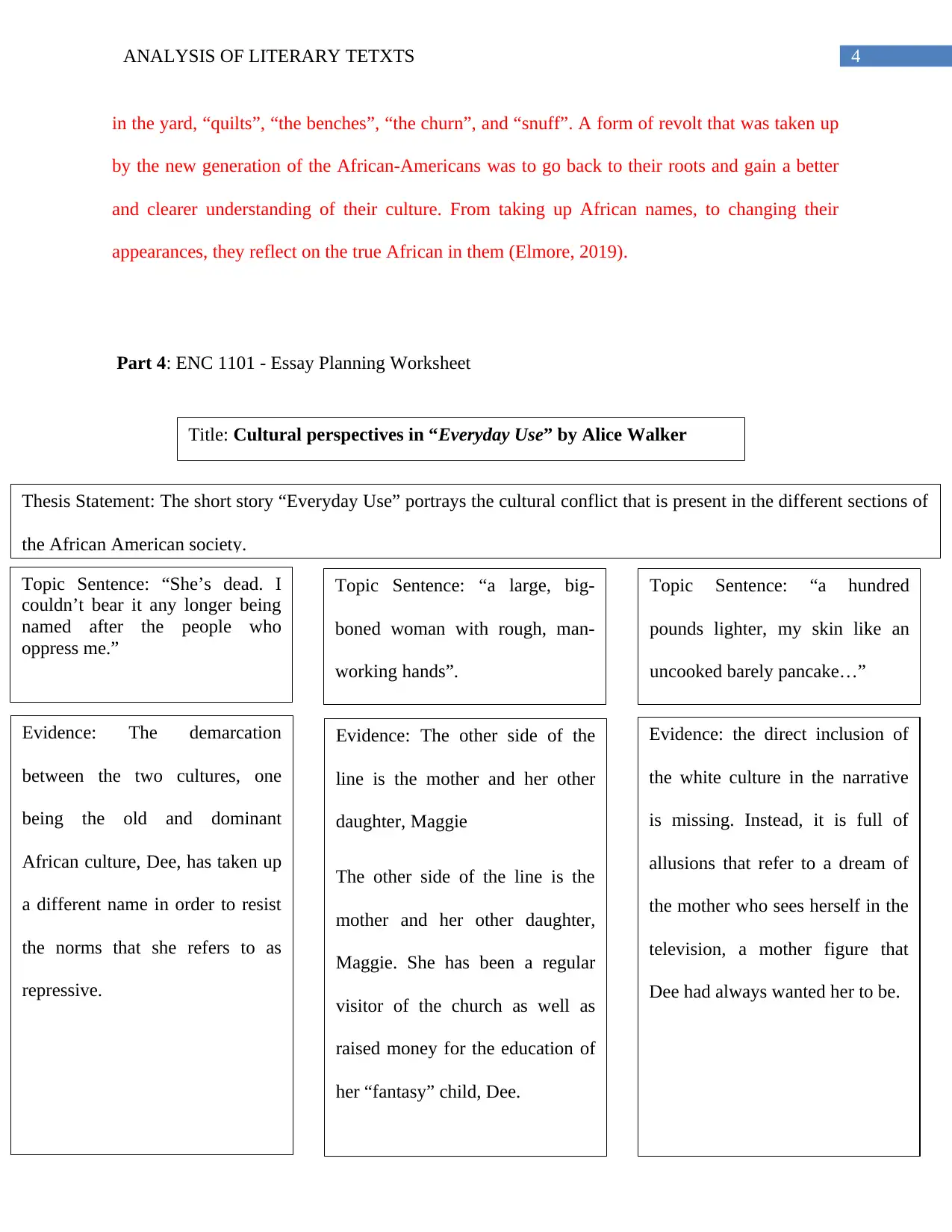
4ANALYSIS OF LITERARY TETXTS
in the yard, “quilts”, “the benches”, “the churn”, and “snuff”. A form of revolt that was taken up
by the new generation of the African-Americans was to go back to their roots and gain a better
and clearer understanding of their culture. From taking up African names, to changing their
appearances, they reflect on the true African in them (Elmore, 2019).
Part 4: ENC 1101 - Essay Planning Worksheet
Topic Sentence: “a hundred
pounds lighter, my skin like an
uncooked barely pancake…”
Topic Sentence: “a large, big-
boned woman with rough, man-
working hands”.
Evidence: the direct inclusion of
the white culture in the narrative
is missing. Instead, it is full of
allusions that refer to a dream of
the mother who sees herself in the
television, a mother figure that
Dee had always wanted her to be.
Evidence: The other side of the
line is the mother and her other
daughter, Maggie
The other side of the line is the
mother and her other daughter,
Maggie. She has been a regular
visitor of the church as well as
raised money for the education of
her “fantasy” child, Dee.
Evidence: The demarcation
between the two cultures, one
being the old and dominant
African culture, Dee, has taken up
a different name in order to resist
the norms that she refers to as
repressive.
Title: Cultural perspectives in “Everyday Use” by Alice Walker
Topic Sentence: “She’s dead. I
couldn’t bear it any longer being
named after the people who
oppress me.”
Thesis Statement: The short story “Everyday Use” portrays the cultural conflict that is present in the different sections of
the African American society.
in the yard, “quilts”, “the benches”, “the churn”, and “snuff”. A form of revolt that was taken up
by the new generation of the African-Americans was to go back to their roots and gain a better
and clearer understanding of their culture. From taking up African names, to changing their
appearances, they reflect on the true African in them (Elmore, 2019).
Part 4: ENC 1101 - Essay Planning Worksheet
Topic Sentence: “a hundred
pounds lighter, my skin like an
uncooked barely pancake…”
Topic Sentence: “a large, big-
boned woman with rough, man-
working hands”.
Evidence: the direct inclusion of
the white culture in the narrative
is missing. Instead, it is full of
allusions that refer to a dream of
the mother who sees herself in the
television, a mother figure that
Dee had always wanted her to be.
Evidence: The other side of the
line is the mother and her other
daughter, Maggie
The other side of the line is the
mother and her other daughter,
Maggie. She has been a regular
visitor of the church as well as
raised money for the education of
her “fantasy” child, Dee.
Evidence: The demarcation
between the two cultures, one
being the old and dominant
African culture, Dee, has taken up
a different name in order to resist
the norms that she refers to as
repressive.
Title: Cultural perspectives in “Everyday Use” by Alice Walker
Topic Sentence: “She’s dead. I
couldn’t bear it any longer being
named after the people who
oppress me.”
Thesis Statement: The short story “Everyday Use” portrays the cultural conflict that is present in the different sections of
the African American society.
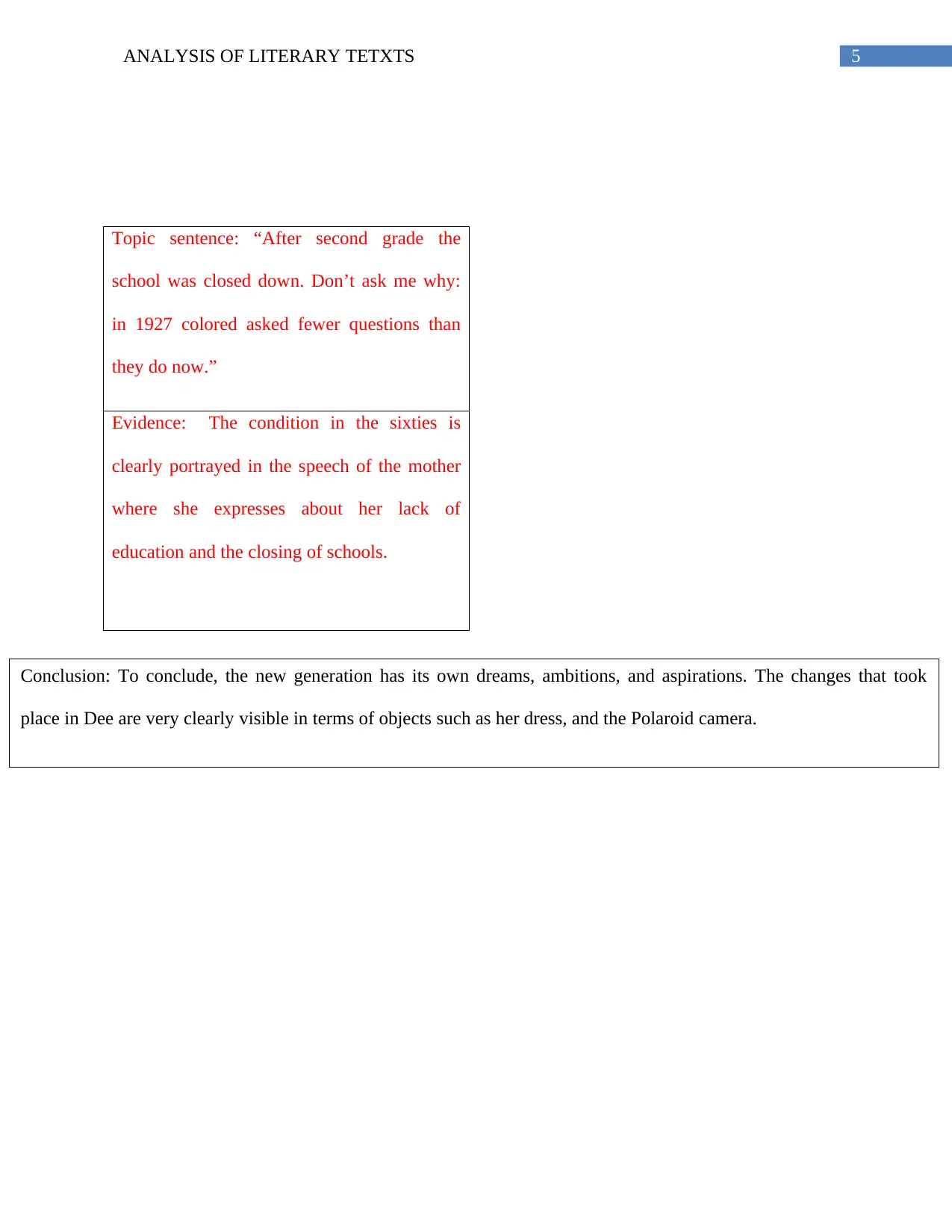
5ANALYSIS OF LITERARY TETXTS
Conclusion: To conclude, the new generation has its own dreams, ambitions, and aspirations. The changes that took
place in Dee are very clearly visible in terms of objects such as her dress, and the Polaroid camera.
Topic sentence: “After second grade the
school was closed down. Don’t ask me why:
in 1927 colored asked fewer questions than
they do now.”
Evidence: The condition in the sixties is
clearly portrayed in the speech of the mother
where she expresses about her lack of
education and the closing of schools.
Conclusion: To conclude, the new generation has its own dreams, ambitions, and aspirations. The changes that took
place in Dee are very clearly visible in terms of objects such as her dress, and the Polaroid camera.
Topic sentence: “After second grade the
school was closed down. Don’t ask me why:
in 1927 colored asked fewer questions than
they do now.”
Evidence: The condition in the sixties is
clearly portrayed in the speech of the mother
where she expresses about her lack of
education and the closing of schools.
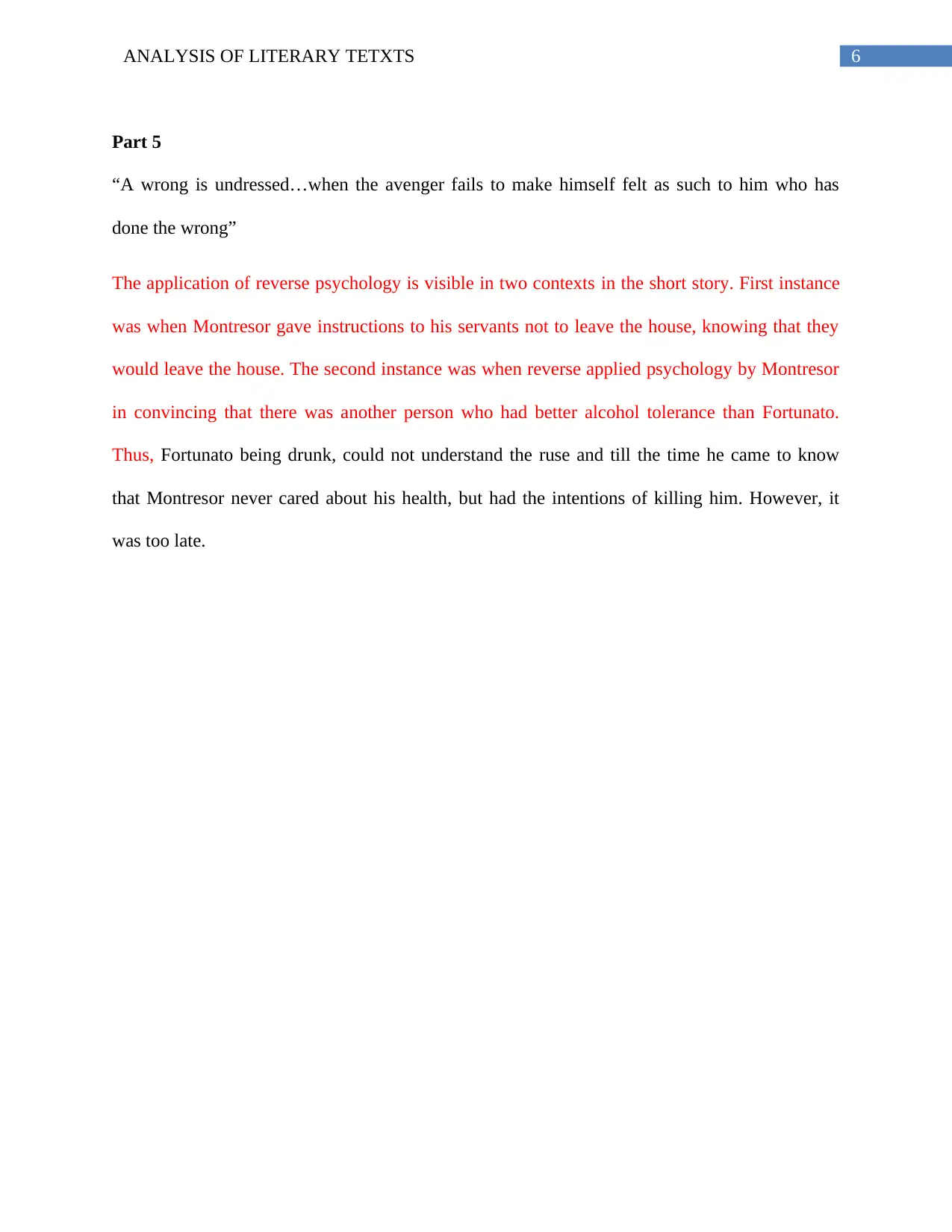
6ANALYSIS OF LITERARY TETXTS
Part 5
“A wrong is undressed…when the avenger fails to make himself felt as such to him who has
done the wrong”
The application of reverse psychology is visible in two contexts in the short story. First instance
was when Montresor gave instructions to his servants not to leave the house, knowing that they
would leave the house. The second instance was when reverse applied psychology by Montresor
in convincing that there was another person who had better alcohol tolerance than Fortunato.
Thus, Fortunato being drunk, could not understand the ruse and till the time he came to know
that Montresor never cared about his health, but had the intentions of killing him. However, it
was too late.
Part 5
“A wrong is undressed…when the avenger fails to make himself felt as such to him who has
done the wrong”
The application of reverse psychology is visible in two contexts in the short story. First instance
was when Montresor gave instructions to his servants not to leave the house, knowing that they
would leave the house. The second instance was when reverse applied psychology by Montresor
in convincing that there was another person who had better alcohol tolerance than Fortunato.
Thus, Fortunato being drunk, could not understand the ruse and till the time he came to know
that Montresor never cared about his health, but had the intentions of killing him. However, it
was too late.
Paraphrase This Document
Need a fresh take? Get an instant paraphrase of this document with our AI Paraphraser

7ANALYSIS OF LITERARY TETXTS
Reference
de Deus Rocha, V. (2018). A Comparative Study Between The Female Characters In The Storm
And The Story Of An Hour By Kate Chopin. Grau Zero, 6(1), 59-73.
Elmore, R. T. R. (2019). Cultural Trauma's Influence on Representations of African American
Identity in Alice Walker's" Everyday Use" (Doctoral dissertation, University of Dayton).
KACHA, S. (2018). Kate Chopin as Feminist in The Story of an Hour (1894) & The Awakening
(1899).
Webb, S. L. (2019). Everyday Colorism: Reading in the Language Arts Classroom. English
Journal, 108(4), 21-28.
ZHAO, Y. (2017). Symbolism of “Quilts” in Alice Walker’s Fictions. DEStech Transactions on
Social Science, Education and Human Science, (adess).
Reference
de Deus Rocha, V. (2018). A Comparative Study Between The Female Characters In The Storm
And The Story Of An Hour By Kate Chopin. Grau Zero, 6(1), 59-73.
Elmore, R. T. R. (2019). Cultural Trauma's Influence on Representations of African American
Identity in Alice Walker's" Everyday Use" (Doctoral dissertation, University of Dayton).
KACHA, S. (2018). Kate Chopin as Feminist in The Story of an Hour (1894) & The Awakening
(1899).
Webb, S. L. (2019). Everyday Colorism: Reading in the Language Arts Classroom. English
Journal, 108(4), 21-28.
ZHAO, Y. (2017). Symbolism of “Quilts” in Alice Walker’s Fictions. DEStech Transactions on
Social Science, Education and Human Science, (adess).
1 out of 8
Related Documents
Your All-in-One AI-Powered Toolkit for Academic Success.
+13062052269
info@desklib.com
Available 24*7 on WhatsApp / Email
![[object Object]](/_next/static/media/star-bottom.7253800d.svg)
Unlock your academic potential
© 2024 | Zucol Services PVT LTD | All rights reserved.




